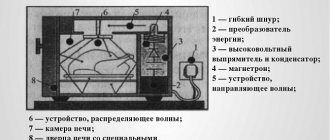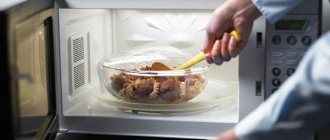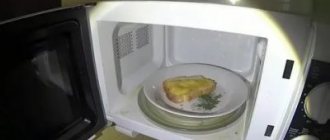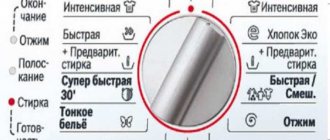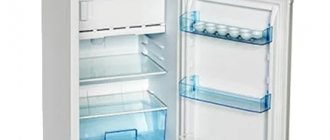Factors when choosing
The main element of the device is a high-frequency wave emitter (magnetron). The power of the microwave depends on it. The main indicator of energy consumption is the power of the device.
The average performance of household microwave ovens is 1000-1200 W. Knowing the power indicator, it is very simple to calculate the amount of energy used per 1 hour of operation of the device: 1000 W = 1 kW.
The second indicator of choice is volume. Its size determines how much energy the microwave consumes. The larger the volume, the more energy will be used. And vice versa, the smaller it is, the more economical the device will be, because internal heating will occur faster.
Compliance with principles when choosing
It is impossible to accurately answer the question: what is the most optimal number of watts? The main factor to focus on is the purposes that indicate what the appliance will be used for. If you only need to heat food, then purchase a 1 kW microwave oven. If you have global goals, then purchase a unit with a power from 1500 W to 2000 W.
Important! This technique will not consume maximum electrical energy. For example, a microwave oven with a power of 2 kW can be set to heat food and the consumption will be only 0.2 kW.
Remember that any device should not be regularly operated at the limit, because this will quickly wear out the equipment and reduce its service life. Buy the device with a reserve to eliminate the possibility of breakdown.
Don't just focus on how to save money. When purchasing a device that does not have certain functions, think about whether they will be useful in the future. Today they produce devices that are economical and energy efficient. Microwaves are equipped with a fuse, which protects against voltage surges.
Types of microwave ovens
You can adjust the microwave power on the control panel. Control systems are of the following types.
Mechanical
The easiest way to regulate energy consumption. Present mainly in solo models. The panel has 2 round rotating switches that allow you to select the operating mode, which directly determines the number of kilowatts consumed per month and the operating time of the timer.
Push-button
The controls are a little easier to use. Presented as a set of buttons located on the instrument panel. They are equipped with models with the ability to operate in several modes.
Sensory
The device is also equipped with buttons, only not mechanical, but touch ones, with which the operating mode is set. Touch control allows you to program the microwave, which eliminates the need to enter the necessary parameters before each use of the device. Touch control also has a drawback due to excessive sensitivity to strong mechanical influences and sudden changes in the electrical network.
What does power depend on?
Modern microwave ovens, in addition to the magnetron (devices that, in fact, are the source of ultra-high range waves), are equipped with additional devices designed to expand functionality. Thus, the total power is equal to the sum of the powers of each unit included in the device. Depending on the specific model, the microwave may additionally have:
- heating element (for the “grill” function);
- one or more fans (for operation in convection mode, air exhaust or magnetron cooling);
- microprocessor-based electronic computing device (for the ability to set programs and enable “intelligent chef” modes).
You can find out how many watts a microwave consumes from the documentation included with each device. The manufacturer also puts this value on a nameplate, usually glued to the back wall of the equipment.
General information about microwave power
The power of microwave ovens depends on their type. In simpler words - the ability of the device to heat and cook food until fully cooked within the time set on the timer or specified by the program. Each variety has its own indicator of this parameter, its own characteristics, advantages and disadvantages.
If the electricity tariff for the user is considered the main parameter, then it is better to give preference to low-power microwave models.
Power of different types of microwave ovens
How many kilowatts a microwave will consume depends on the modification of the device and the volume of the chamber for storing food:
- in a device with a grill 1.5-2.8 kW;
- in simple models without any bells and whistles 0.5-1.5 kW;
- The set includes a grill plus a 2-3 kW convector.
The presence of different modes should not be discounted. For example:
- at a low heating level, the device uses 10% of the total power;
- on average – up to 50%;
- at maximum – all 100%.
Microwaves solo
Such microwave ovens belong to the budget price category. Although there are expensive options in this segment. The markup is mainly due to the design and higher quality internal filling, including the material used to make the protective layer.
The average power is 900 W, used for preparing simple dishes, defrosting meat, and heating. Inexpensive models are often purchased for offices. For home use, it is better to choose more expensive options with additional functions and capabilities.
With grill
This type of microwave oven can heat ready-made food, defrost it, and prepare more complex dishes compared to the previous version. The average kW rating of these ovens is 1500. Having a grill is an alternative to an oven. That is, in addition to preparing dishes, the device has the function of baking until “crispy.”
There are 2 types of grill. How much electricity do microwaves use depending on the grill? The same number, but there are still differences between them.
With convection
The energy consumption of a convection microwave is 1350-2000 kW. By convection we mean the presence of a fan built into the oven. It creates and supplies a stream of hot air, which, acting on the products, makes them ready. Cooking is faster and better quality than using microwaves from a grill.
There are models that combine grill and convection functions. In them, manufacturers increase the volume of the chamber, but, on the contrary, reduce the electrical part. Inverter options save energy consumption by automatically adjusting the temperature for cooking.
With steam generator
A tandem using the functions of a microwave and a steamer in one device is good and practical. Here, microwaves can work in ovens in the baking, heating or defrosting mode, and a steamer built into the device in the form of a special design. The latter contains a vessel for water and a special tray where water or juice released from products is collected. Each manufacturer offers its own options in terms of capacity.
General information about microwave power
- Its source is a magnetron, which is the most important element of any microwave oven and is something similar to a light bulb. When the device is turned on, this element produces ultra-high-frequency waves, due to which food products are heated.
- The power determines the capabilities of the microwave. Its value determines how hot and quickly food can be heated, and what can be cooked in this appliance.
- Power units are represented in watts or kilowatts.
- The power indicator depends directly on the dimensions of the structure. The larger the furnace, the greater its energy needs. Consequently, in this case, electricity consumption increases.
When purchasing a microwave oven, special attention should be paid to its performance, which is the main criterion when choosing a product. This indicator is determined by power and can take values of 600-15000 W. The higher it is, the more efficient the furnace is and the greater the number of functions it performs.
The size of the power directly depends on some characteristics of the microwave. These include the device's capacity and the number of built-in functions.
Microwave operating modes
A distinctive feature of this type of oven is the speed of cooking while preserving all the taste and vitamins in the products. The microwave wave exceeds the boiling point, this makes it possible to prepare dishes for the diet menu. Among the main parameters in the technical characteristics, the volume of the loading chamber is considered important. It directly depends on the power of the microwave oven. The greater the number of products loaded into it, the more power is required for their preparation, including heating, and therefore the energy carrier.
In other words, the power consumption of a microwave oven depends not so much on the selected mode as on the amount of products loaded into the chamber.
For clarity. Let's take some dish to heat in the simplest model of a microwave oven. Let's set the time period to 2 minutes. (this will require 0.6 kW of electricity). In a regular microwave it will heat up throughout the entire time interval. In a microwave oven this process will happen in a matter of seconds.
Microwave device
At the heart of the microwave oven design is a magnetron. This is a lamp that produces high-frequency waves that shake the water molecules inside the product, resulting in the heating of the dish. This is the principle of operation of a microwave oven.
The power of the lamp (magnetron) determines the power of the device. Of course, part of the electricity consumed goes to the backlight and the motor with which the plate rotates. But the main part is taken over by the magnetron.
Among the technical characteristics by which a microwave oven is selected, one more can be distinguished - the volume of the loading chamber. It directly depends on the power of the microwave oven, since the more products are loaded into the device, the more electricity will be required to generate high-frequency waves for heating. Thus, electricity consumption depends not only on the selected mode, but also on the number of products inside the chamber. For example, if it takes 1-2 minutes to heat a dish in a small microwave (the device will consume 0.6 kW of electricity), then in a more powerful microwave oven this process will occur in a matter of seconds.
Read also: How to choose a microwave for the kitchen
Therefore, the degree of heating of food is one of the factors that you should pay attention to, taking into account the power characteristics of the microwave oven.
- When heating dishes quickly, the device will consume 0.9-1.0 kW.
- Normal heating or leisurely cooking is 0.6-0.8 kW.
- Defrosting food will require 0.2-0.4 kW.
- When heating food lightly, the device will consume 100 watts.
How to find out power
The amount of electricity consumption can be found out when buying a microwave oven from the packaging label. Some manufacturers indicate this parameter on the device body. The information is usually located on the back of the device. It does not indicate the amount of electricity consumed in standby mode. The information provided by the manufacturer is the designation in watts. International marking is W. You can calculate the rated power yourself by experiment, this will be the answer to the question of how to find out the power of the microwave that was purchased.
Place a glass of water in the chamber and, bringing it to a boil, monitor the time. Compare with the table indicators:
| Time involved | Estimated Power Strength |
| 1.5 min. | 1200 W |
| 2 minutes. | 1000 W |
| 2.5 min. | 800 W |
| 3 min. | 700 W |
| 4 min. | 600 W |
Having found out the power of your device, you can make adjustments to the cooking program.
Microwave power
Microwave power is one of the main characteristics that determines the capabilities of this kitchen assistant. This parameter determines how hot the oven can be heated and what dishes can be cooked at a particular set value.
It's a pretty obvious fact: reheating sandwiches or cooking raw meat products requires different temperatures and different cooking times.
What do you need to know about the main characteristics of a microwave oven in order to correctly navigate this issue?
Microwave energy consumption
How much energy does a microwave consume? This question worries many when purchasing a device. To answer this correctly, you need to know the power of the microwave oven you are going to purchase. This parameter is measured in watts (W) and kilowatts (kW).
The larger the volume of the microwave, the greater its power and the more electricity it consumes.
The maximum value of power consumption and operating modes of the device must be indicated in the instructions.
Modern microwave ovens are equipped with a power regulator. This concept in relation to microwaves differs from the usual one. For example, if you set the regulator to 100% and the timer to 60 minutes, then in this case the magnetron will work continuously for an hour. And if you set the regulator to 50%, then the magnetron will work instead of 60 minutes for only 30, turning on and off several times during a given time interval.
Types of microwave ovens
Depending on the equipment, modern microwave ovens are divided into three groups:
- Conventional models (solo), which perform a minimum of functions, are used for heating ready-made food, preparing hot sandwiches and defrosting food.
- Microwaves equipped with a grill are intended for cooking.
- Models equipped with grill and convection are used for cooking and baking.
The total power consumption of the devices is shown in the table below.
| Equipment | Total power consumption |
| Magnetron | 0.3–1.3 kW |
| Magnetron + grill | 1.4 – 2.7 kW |
| Magnetron + grill + convector | 2.5 – 3.5 kW |
It should be noted that modern microwave ovens, even when in standby mode, still consume electricity.
How much electricity is consumed if the device remains connected to the network? It would seem that the consumption of electricity should be insignificant. No matter how it is! Depending on the model and manufacturer, it consumes from 1.5 to 4 W per hour.
Microwave operating modes
Power consumption depends on the mode of use of the oven and the cooking speed:
- Fast cooking - about 1 kW.
- Measured cooking and heating of ready-made food - about 700-800 W.
- Defrosting food – 300-400 W.
- Rapid heating of ready meals – approximately 100 W.
The figures given are average values. Of course, power consumption also depends on the volume of products being processed: for example, to heat a 0.5 liter bowl of soup, less electricity will be consumed than for 1 liter .
Practical advice
When purchasing a microwave, you should always remember the maximum total power of the device: will the electrical network in your apartment withstand this load.
If you plan to use the microwave oven only for heating ready-made dishes, then you should not buy a powerful device that will consume many times more electricity than a regular microwave.
How to adjust power
The trick to cooking, no matter what power is hidden under the concept, is that the kilowatts consumed can be adjusted. This can be reproduced because the recipes do not indicate how much power is needed. Power strength indicates:
- cooking time. The faster a dish is cooked, the more electricity it consumes;
- The heating mode can be set independently from 10% to 100%;
- volume of the prepared dish. The setting must be suitable for a microwave oven. The increase in volume depends on the capabilities of the device.
The more power a stove has , the more electricity it consumes. You can adjust it manually. This is not difficult to do.
If the recipe of the dish to be prepared is designed for 600 W, and the device produces 1000 W, then you need to manually set the power - this will be 60% of the full rating.
The value must be found by solving elementary proportionality. In cases where the microwave oven is inferior to the standard, you will not be able to set the power yourself, then you will need to increase the cooking time.
How to set the desired power yourself and is it possible? What power should a microwave have for individual dishes?
The dependence is as follows: for every missing 100 W and for every minute of time, you need to add 10 seconds. Let's assume that the recipe requires 3 minutes. time at a power of 1000 W. But the device produces only 800 W, the cooking time will need to be increased to 3 minutes. 30 sec.
What is the maximum total power consumption of a microwave oven?
The load on the electrical network as a whole directly depends on the amount of electrical energy consumed. How much energy a microwave will consume is an important parameter and should be taken into account at the model selection stage. Many modifications are equipped with additional functionality in the form of grill, microwave, convection. And the more of them there are in the device, the more power it has, which means the more energy it will consume. Consequently, the load on the home electrical network will be high:
- if the device only has a microwave function, the power in kW will be 0.5-1.5;
- if there is a grill and microwave – 1.5-2.8 kW;
- functionality in the form of grill + microwave + convection – 2-3 kW.
The energy consumption consumed by fans also should not be discounted, but taken into account as a single indicator. Some models have not one, but several fans. They are necessary for the device for convection and cooling of the heater.
The indicator of Watts consumed by a microwave oven is influenced by another consumer in the device - an electronic computer. It is necessary for the normal implementation of cooking programs, the “smart chef” cooking mode. Each such model indicates which program needs to be turned on in order to perform one of the following tasks: heat porridge, cook vegetables, defrost meat, and so on.
A lot of energy is wasted when the device warms up - this must be kept in mind.
Microwave electricity consumption per hour
The documentation rarely indicates the amount of power in watts generated by the heater (magnetron).
Let’s look at how many watts a microwave will consume using an example.
The power of our device (without grill) is 1000 W. About 5 times a day we heat up food, spending 2 minutes on it. Spend 10 minutes a day warming up:
- It turns out that the device works for heating for 300 minutes a month;
- 16.6 W will be used per minute;
- for one-time heating 33.2 W (this is 0.033 kW);
- per day 167 W (this is 0.17 kW);
- per month 5010 (5 kW) with 10 minutes of operation;
- for 20 minutes/day 10 kW.
The power consumption of a microwave oven can be found on the plate (nameplate), which is attached to the surface of the back of the device or in the instructions for use.
How many kilowatts does a microwave consume depending on the chosen cooking method?
When choosing a microwave for home use, it is very important to pay attention not only to the functionality of the device, but also to the power parameters - that is, how much electricity the microwave will consume in operating condition. Power characteristics of the microwave oven in the main modes:
- fast heating uses 0.9-1.0 kW of electricity;
- defrosting will consume 0.2-0.4;
- normal mode – 0.6-0.8;
- light heating 0.1 kW.
The standby mode also draws electricity of 1.5-4 W. The user here is an electronic panel on which the current time is calculated or indicated. Before cooking, you need to select the operating mode of the device, and knowing how much energy it uses per hour of operation, you can regulate its consumption, saving on little things. For example, heat porridge not in the microwave, but on a gas stove.
How much energy does a microwave consume when operating in grill mode?
When choosing a device with this function, you need to decide on the type of grill and give preference to a more economical option. The quartz option is considered more economical. The heating element will consume 0.9-2 kW. Knowing the exact indicators of electricity consumption, you can regulate the number of hours the grill operates in order to save money. Owners of microwave equipment, in fact, do not need either a gas stove with an oven, or an electric one if the electricity tariff is satisfactory.
Modern microwave ovens can bake, stew, boil, steam, bake until crispy. The only negative is the high energy consumption, especially if the device combines several heating elements. The efficiency of a microwave with a grill and not only with it is affected by:
- Magnetron power (the main element of any microwave oven).
- Additional installed devices (grill, convection, steam generator).
- The volume of products loaded into the chamber.
Each cooking mode consumes a different amount of electricity:
- Just microwave – 0.3-1.3 kW.
- Microwave with grill function – 1.4-2.7 kW.
- Microwave with convection and grill – 2-3 kW.
- Models combining: microwave, grill, steam generator and convection in one device - 2.5-3.5 kW.
How much electricity an electric microwave oven consumes is now clear, which one to choose is everyone’s prerogative.
Determination of energy expenditure
Let's look at each indicator on which microwave consumption depends.
Modes and their consumption
Below is a table of modes and their average consumption in kW/hour
Consumption calculations depending on power
To determine the power of your microwave, find a sticker or packaging on it that says: power xxxx (value 850) W, kW or W.
Let’s say that we have a 1000-watt stove in our house, which means it consumes ≈ 1000 W or 1 kW/hour in one hour of operation in maximum mode.
We recommend: Procedure for replacing a cold or hot water meter
To determine kilowatts for 1 minute of operation you need: 1000(power)/60(minutes per hour) ≈ 16.7 W ≈ 0.0167 kW/per minute.
If the food is heated for 3 minutes: 0.0167 * 3 = 0.0501 kW/ for one heating lasting 3 minutes.
For example, we reheat food 4 times a day: 3(number of minutes of operation) * 0.0167 kW(per 1 minute of operation) * 4(number of reheats) = 0.2004 kW/per day.
Consumption per month with such work will be : 0.2004 (consumption per day) * 30 (days per month) = 6.012 kW/month.
To calculate the amount you need: 6,012 * 3.5 rubles (tariff for 1 kW/hour, in each region, district, city and village there are different tariffs) = 21,042 rubles you will have to pay for using the microwave.
Do not forget that we calculated the consumption for a microwave oven at 1000 W. Other furnaces with more or less power will have different meanings and costs!
Microwave equipment
A table is provided with equipment (grill and grill + convection) and consumption for 1 hour of operation. The data is within the limits because everything depends on the power, for example, an 800 W oven consumes 0.8 kW/hour, and if it has a grill, then the consumption will increase to 1.8 kW/hour.
We recommend: Sensors for detecting gas leaks
